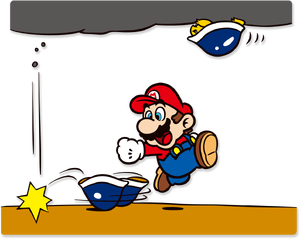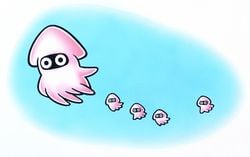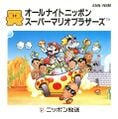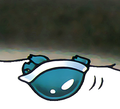User:Doc von Schmeltwick/Projects/Early merges
The following are enemies that were once officially split, but no longer are except in cases where the old games are referenced. We currently do not split them, but here is a demo for how we could.
Sky Blooper
| Early merges | |
|---|---|
Sprite of a Sky Blooper using the land palette from Super Mario Bros.: The Lost Levels | |
| First appearance | Super Mario Bros.: The Lost Levels (1986) |
| Latest appearance | Game & Watch: Super Mario Bros. (2020) |
| Variant of | Blooper |
Sky Bloopers[1] are an airborne type of Bloober found in Super Mario Bros.: The Lost Levels and its reissues. They use the exact same programmed object as the game's normal Bloobers, but as they are found above water, they swim through the air and can be stomped. Due to sharing a palette with Goombas and similar entities, they typically appear in a tan color, though they also appear in World 8-4 with the white-and-gray coloration used for castle levels.
In Super Mario All-Stars, they are all pink, as with normal Bloobers, as there is no longer any palette switching between underwater and land levels in favor of using a blue filter for water.
In the Minus World in the original Super Mario Bros., Bloobers can spawn in a cave stage (making them be colored blue), functioning similar to Sky Bloopers. Additionally, in Super Mario Maker and its follow-ups, Bloopers act similar if placed in a non-water level, though they are not differentiated in any way.
Gallery
Super Mario All-Stars (Super Mario Bros.)
Names in other languages
| Language | Name | Meaning | Notes |
|---|---|---|---|
| Japanese | Kūchū Gessō |
Sky Blooper | |
| French | Bloober aérien[3] | Aerial Blooper | |
| Italian | Calamako volante[4] | Flying Blooper |
OkaP
| Early merges | |||
|---|---|---|---|
Sprite of OkaP using the land palette from Super Mario Bros.: The Lost Levels | |||
| First appearance | All Night Nippon: Super Mario Bros. (1986) | ||
| Variant of | Goomba | ||
| |||
OkaP are enemies in All Night Nippon: Super Mario Bros. taking the place of Little Goombas. They are a form taken by Japanese DJ Sunplaza Nakano after Bowser lured him into visiting him and cursed him. Their name is derived from Sunplaza Nakano's theme song in All Night Nippon. They are one of two enemy replacements in the game (both by Sunplaza Nanako), the other being Pakkun OkaP.
Gallery
Names in other languages
| Language | Name | Meaning | Notes |
|---|---|---|---|
| Japanese | オカピー[5] Okapī |
OkaP |
Pakkun OkaP
| Early merges | |||
|---|---|---|---|
Sprite of Pakkun OkaP using the land green palette from Super Mario Bros.: The Lost Levels | |||
| First appearance | All Night Nippon: Super Mario Bros. (1986) | ||
| Variant of | Piranha Plant | ||
| |||
Pakkun OkaP are enemies in All Night Nippon: Super Mario Bros. taking the place of Piranha Plants. They are a form taken by Japanese DJ Sunplaza Nakano after Bowser lured him into visiting him and cursed him. Their name is derived from Sunplaza Nakano's theme song in All Night Nippon. They are one of two enemy replacements in the game (both by Sunplaza Nanako), the other being OkaP.
Gallery
Names in other languages
| Language | Name | Meaning | Notes |
|---|---|---|---|
| Japanese | パックンオカピー[6] Pakkun Okapī |
Piranha OkaP |
Upside-down Piranha
| Early merges | |
|---|---|
 Artwork of an Upside-down Piranha from Super Mario Land | |
| First appearance | Super Mario Land (1989) |
| Variant of | Piranha Plant |
Upside-down Piranhas, also referred to as Upside Down (Headstand) Pakkun,[7] Reverse Pakkun[8] and Upside-down Piranha Plant,[9] are a type of Piranha Plant that appear in downward-facing pipes in Sarasaland, granting 400 points when defeated rather than the usual 100. Although downward-facing Piranha Plants are found in many games (including being the only normal Piranha Plants in Super Mario World), they are only consistently treated as a distinct enemy in the context of Super Mario Land, though "Hanging Piranha Plant" was once used by Nintendo Power in coverage for Super Mario Bros. 3.[10] Additionally, they never grant extra points in other games.
In Super Smash Bros. Ultimate, Upside-down Piranhas are mentioned briefly by Viridi during Palutena's Guidance dialogue for Piranha Plant. Unlike most in the list which are given in their order of first appearance, they are listed near the very end, coming after the Super Mario Odyssey Piranha Plant types and before the Petey Piranha variations.
Names in other languages
| Language | Name | Meaning | Notes |
|---|---|---|---|
| Japanese | 逆さパックン[11] Sakasa Pakkun |
Upside-down Piranha (Plant) | |
| さかさパックン Sakasa Pakkun | |||
| Dutch | Omgekeerde Piranha | Reverse Piranha | |
| Omgekeerde Pakkun[12] | Reverse Pakkun flower | Super Mario Land | |
| French (NOA) | Fleur Piranha renversée | Reversed Piranha Flower | |
| French (NOE) | Plante Piranha renversée | Reversed Piranha Plant | |
| Fleur Pakkun inversée[13] | Inversed Pakkun flower | Super Mario Land | |
| German | Kopfüber-Piranha-Pflanze | Upside-down Piranha Plant | |
| Italian | Upside Down (Headstand) Pakkun[14] | - | |
| Pianta Piranha capovolta[15][16] | Upside-down Piranha Plant | ||
| Pianta Piranha a testa in giù[17] | Head-down Piranha Plant | ||
| Russian | Пиранья-перевертыш Piran'ya-perevertysh |
Flipped-over Piranha | |
| Spanish (NOA) | Planta Piraña al revés | Upside-down Piranha Plant | |
| Spanish (NOE) | Planta Piraña del revés | Upside-down Piranha Plant |
Upside-down Buzzy Beetle
| Early merges | |||
|---|---|---|---|
 Artwork of a pair of Upside-down Buzzy Beetles around Mario from Super Mario Bros. 3 (retouched for Famicom 35th anniversary) | |||
| First appearance | Super Mario Bros. 3 (1988) | ||
| Latest appearance | Super Mario All-Stars Limited Edition (2010) | ||
| Variant of | Buzzy Beetle | ||
| |||
Upside-down Buzzy Beetles,[18] previously simply localized as Buzzy Beetles,[19] are ceiling-dwelling versions of standard Buzzy Beetles found in Super Mario Bros. 3. They walk forward until Mario walks near under one, at which point it falls and spins in his direction in its upside-down shell. They appear in World 2-![]() Pyramid and World 4-3.
Pyramid and World 4-3.
Later games starting with Paper Mario give the Upside-down Buzzy Beetles' properties to normal Buzzy Beetles as an alternate behavior, rather than treating them as a distinct type of enemy.
Gallery
Names in other languages
| Language | Name | Meaning | Notes |
|---|---|---|---|
| Japanese | さかさメット[20] 逆さメット[21] Sakasa Metto |
Upside-down Buzzy Beetle | |
| Italian | Nella capovolta | Upside-down Buzzy Beetle | |
| Sole malvagio[22] | Angry Sun (mistake) |
Upside-down Spiny
| Early merges | |||
|---|---|---|---|
Original sprite of an Upside-down Spiny | |||
| First appearance | Super Mario Bros. 3 (1988) | ||
| Latest appearance | Super Mario All-Stars Limited Edition (2010) | ||
| Variant of | Spiny | ||
| |||
Upside-down Spinies[23] are ceiling-dwelling versions of standard Spinies found in Super Mario Bros. 3. They walk forward until Mario walks near under one, at which point it falls and spins in his direction in its upside-down shell. They only appear in World 4-3.
Later games starting with New Super Mario Bros. give the Upside-down Spinies' properties to normal Spinies as an alternate behavior, rather than treating them as a distinct type of enemy.
Names in other languages
| Language | Name | Meaning | Notes |
|---|---|---|---|
| Japanese | さかさトゲゾー[24] Sakasa Togezō |
Upside-down Spiny | |
| Italian | Koopistrice al contrario[25] | Upside down Spiny |
Scattering Blooper
| Early merges | |
|---|---|
 Artwork of Bloober with kids or Scattering Bloober from Super Mario Bros. 3 | |
| First appearance | Super Mario Bros. 3 (1988) |
| Latest appearance | Super Mario All-Stars Limited Edition (2010) |
| Variant of | Blooper Nanny |
Scattering Bloopers[26], originally known as Scattering Bloobers,[27] are a type of Blooper Nanny (themselves originally called "Bloober with kids") from Super Mario Bros. 3. Unlike the Blooper Nannies of Water Land, the Scattering Bloopers are found in Ice Land and Pipe Land. Rather than simply have their babies follow them, they have them cluster around the parent when Mario approaches them, then slowly spiraling outward past the edges of the screen. The parent replaces them shortly afterward.
Later games starting with New Super Mario Bros. give the Scattering Bloopers' properties to normal Blooper Nannies as their primary behavior, though their original more passive behavior returns in Super Mario Maker.
Names in other languages
| Language | Name | Meaning | Notes |
|---|---|---|---|
| Japanese | 散らしゲッソー[28] Chirashi Gessō |
Scattering Blooper | |
| Italian | Scattering Bloober[29] | Scattering Bloober |
References
- ^ Super Mario Bros.: The Lost Levels entry on the official Mario Portal. nintendo.co.jp (English). Retrieved August 13, 2022. (Archived August 13, 2022, 14:35:18 UTC via archive.today.)
- ^ January 28, 1992. Super Mario-kun Volume 3. Shogakukan (Japanese). ISBN 4-09-141763-9. Page 54.
- ^ July 4, 2018. Super Mario Encyclopedia : Les 30 premières années. Soleil Productions (French). ISBN 2302070046. Page 19 and 27.
- ^ November 15, 2018. Super Mario Bros. Enciclopedia. Magazzini Salani (Italian). ISBN 889367436X. Page 27.
- ^ All Night Nippon: Super Mario Bros. instruction booklet. Page 12.
- ^ All Night Nippon: Super Mario Bros. instruction booklet. Page 13.
- ^ 1989. Super Mario Land instruction booklet. Nintendo of America (American English). Page 13.
- ^ 1991. Nintendo Game Boy Player's Guide. Nintendo of America (American English). Page 5.
- ^ English Super Mario Land entry on the official Mario Portal. nintendo.co.jp (English). (Archived August 13, 2022, 14:23:05 UTC via archive.today.)
- ^ Tilden, Gail, et al. (June 1990). Nintendo Power Volume 13. Nintendo of America (American English). Page 9.
- ^ 1989. スーパーマリオランド (Sūpā Mario Rando) instruction booklet. Nintendo (Japanese). Page 13.
- ^ Super Mario Land Nintendo 3DS Virtual Console electronic manual (Dutch). Tab 14: "Personages"..
- ^ Super Mario Land French instruction booklet. Page 13.
- ^ Super Mario Land manual. Nintendo (Italian). Page 13.
- ^ Super Mario Land (3DS - Virtual Console) e-manual. Nintendo (Italian). Page 14.
- ^ Piranha Plant's Palutena's Guidance, in Super Smash Bros. Ultimate
- ^ November 15, 2018. Super Mario Bros. Enciclopedia. Magazzini Salani (Italian). ISBN 889367436X. Page 47.
- ^ English Super Mario Bros. 3 entry on the official Mario Portal. nintendo.co.jp. Retrieved August 13, 2022. (Archived August 13, 2022, 14:26:17 UTC via archive.today.)
- ^ Super Mario Bros. 3 English manual, page 37
- ^ Sakai, Kazuya (Ambit) et al. (October 19, 2015). Super Mario Bros. Hyakka: Nintendo Kōshiki Guidebook, Super Mario Bros. 3 section. Shogakukan (Japanese). ISBN 978-4-09-106569-8. Page 36.
- ^ Famicom 40th anniversary - Super Mario Bros. 3 page, "enemy characters" section. Nintendo.com (Japanese). Retrieved July 9, 2024.
- ^ November 15, 2018. Super Mario Bros. Enciclopedia. Magazzini Salani (Italian). ISBN 889367436X. Page 36.
- ^ English Super Mario Bros. 3 entry on the official Mario Portal. nintendo.co.jp (English). Retrieved August 13, 2022. (Archived August 13, 2022, 14:26:17 UTC via archive.today.)
- ^ Sakai, Kazuya (Ambit) et al. (October 19, 2015). Super Mario Bros. Hyakka: Nintendo Kōshiki Guidebook, Super Mario Bros. 3 section. Shogakukan (Japanese). ISBN 978-4-09-106569-8. Page 36.
- ^ Super Mario Bros. 3 Italian manual. Page 36.
- ^ English Super Mario Bros. 3 entry on the official Mario Portal. nintendo.co.jp. Retrieved August 13, 2022. (Archived August 13, 2022, 14:26:17 UTC via archive.today.)
- ^ 1990. Super Mario Bros. 3 instruction booklet. Nintendo of America (American English). Page 36.
- ^ スーパーマリオブラザーズ3 (Sūpā Mario Burazāzu Surī) instruction booklet. Nintendo (Japanese). Page 37.
- ^ Super Mario Bros. 3 Italian instruction booklet. Page 36.










